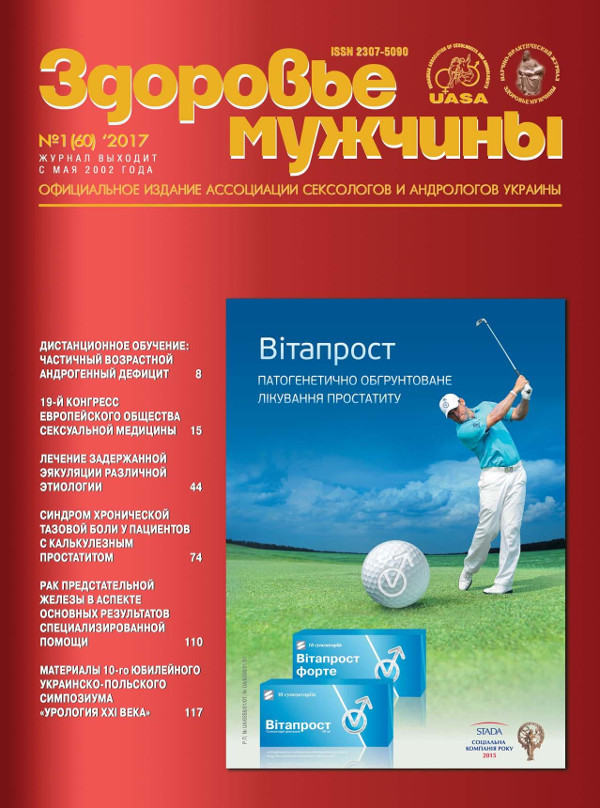The prediction of silodosin expected effectiveness in the lower urinary tract symptoms treatment with benign prostatic hyperplasia patients
##plugins.themes.bootstrap3.article.main##
Abstract
The objective: of this study was to predict the results of silodosin treatment of benign prostatic hyperplasia patients with lower urinary tract symptoms based on pharmacourodynamical test with a single dose of 8 mgs of silodosin (urorec).
Patients and methods. The given data concerning the state of the urine flow at urination 51 benign prostatic hyperplasia patients after pharmacourodynamical test realization with uroselective alpha1-adrenoblockers silodosin and 24 patients after silodosin treatment have been presented for a month. The study was conducted with the help of uroflowmetr «Flow-K».
Results. The test with a reception 8 mgs silodosin (urorec) allows promptly (within a few hours) obtain an increase in urine flow velocity indicators on average 26–32%. Results of uroflowmetry after pharmacourodynamical test realization with a reception 8 mgs of silodosin (urorec) with benign prostatic hyperplasia patients which do not differ from those ones after silodosin (urorec) treatment for a month. In the absence of a positive response to receiving silodosin necessary to carry out further investigation to determine the patency of the urethra and detrusor state.
Conclusion. A pharmacourodynamical silodosin test is the high informative method of prognostication of the silodosin treatment expected results.
##plugins.themes.bootstrap3.article.details##

This work is licensed under a Creative Commons Attribution 4.0 International License.
Authors retain the copyright and grant the journal the first publication of original scientific articles under the Creative Commons Attribution 4.0 International License, which allows others to distribute work with acknowledgment of authorship and first publication in this journal.
References
Chapple C.R. Alpha antagonists – from initial concept to routine clinical practice // Eur. Urol. – 2006. – V. 50, N 4. – P. 635–642.
Manjunatha R., Pundarikaksha H.P., Madhusudhana H.R. et al. A randomized, comparative, open-label study of efficacy and tolerability of alfuzosin, tamsulosin and silodosin in benign prostatic hyperplasia // Indian J. Pharmacol. – 2016. – V. 48, N 2. – P. 134–140.
Стусь В.П. Сравнительный анализ адреноблокаторов для лечения доброкачественной гиперплазии предстательной железы // Урологія. – 2013. – No 1. – С. 1–7.
Marks L.S., Gittelman M.C., Hill L.A. Rapid efficacy of the highly selective A1-adrenoceptor antagonist silodosin in men with signs and symptoms of benign prostatic hyperplasia: pooledresults of 2 phase 3 studies. // J. Urol. – 2009. – V. 181, N 6. – P. 2634–2640.
European Medicines Agency. CHMP assessment report for Urorec: procedure no EMEA/H/C/001092 [online]. Available from URL: http://www.ema.europa.eu [Accessed, 2011 Mar 2].
Chapple C.R., Montorsi F., Tammela T.L. Silodosin therapy for lower urinary tract symptoms in men with suspect benign prostatic hyperplasia: results of an international, randomized, double-blind, placebo- and activecontrolled clinical trial performed in Europe // Eur. Urol. – 2011. – V. 59. – P. 342–352.
Яровой С.К. Силодозин – новый препарат группы селективных α1-адреноблокаторов // Экспериментальная и клиническая урология. – 2012. – No 3. – С. 57–62.
Ухаль М.И. О целесообразности использования высокоселективного α-адреноблокатора силодозина у больных с предшествующей длительной консервативной терапией доброкачественной гиперплазии предстательной железы и в послеоперационный период // Здоровье мужчины. – 2015. – No 3. – С. 128–130.
Винаров А.З. Медикаментозное лечение больных гиперплазией предстательной железы: Автореф. дисс.... д-ра мед. наук. – М., 1999. – 41 с.
Квятковский Е.А., Квятковская Т.А., Квятковский А.Е. Объективизация нарушений уродинамики у больных с хроническим простатитом с использованием урофлоуметрии в сопоставлении с данными ультразвукового исследования // Здоровье мужчины. – 2012, No 3. – С. 168–171.





